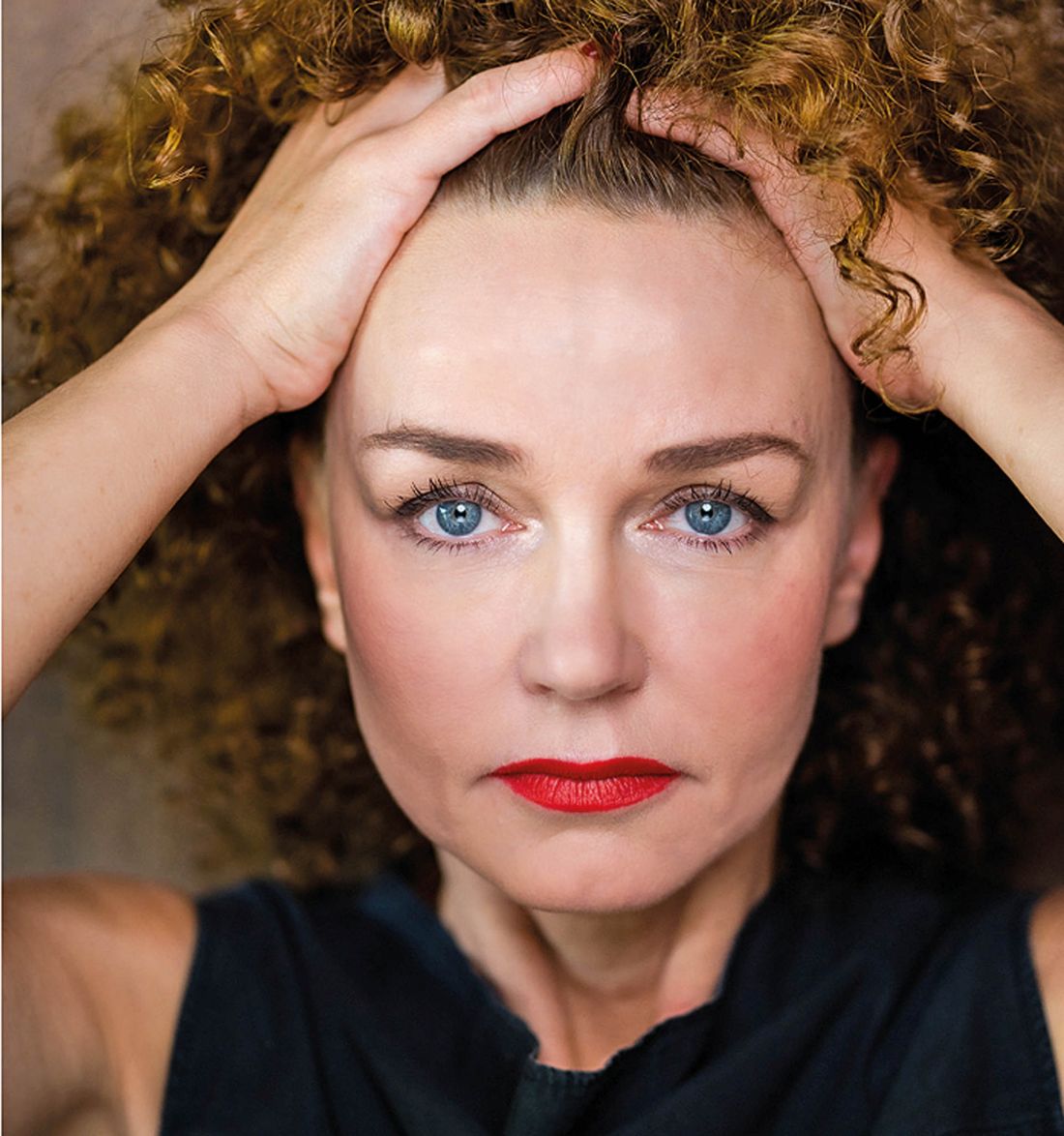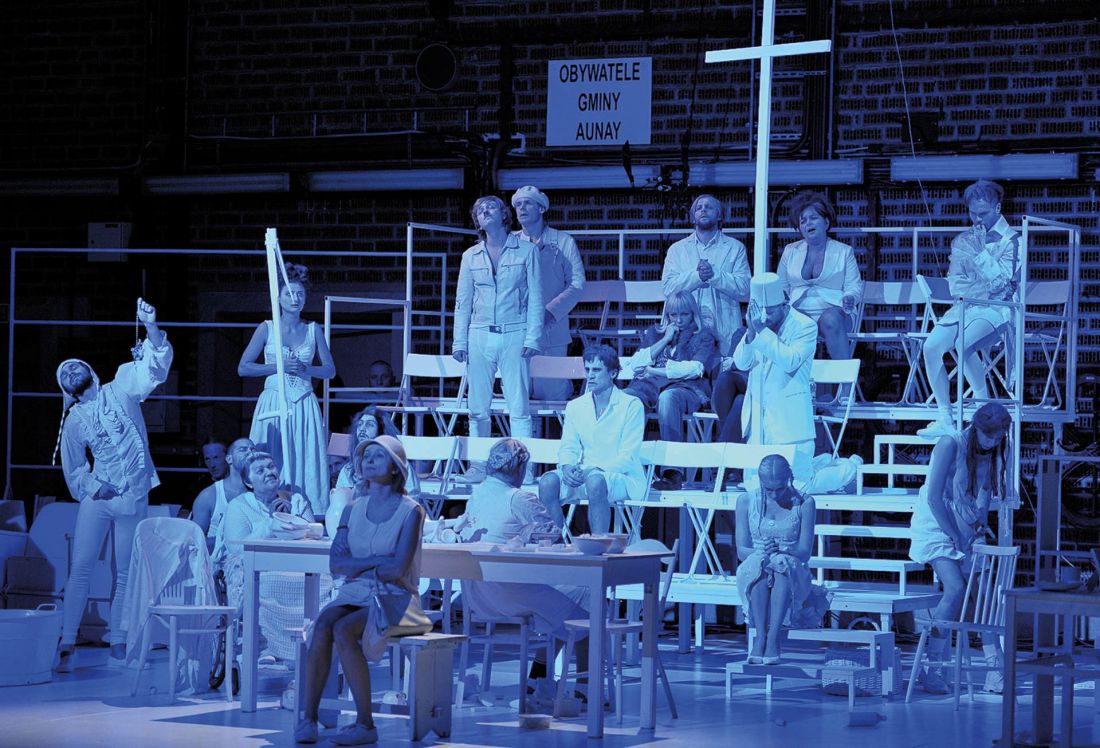Interview from A&B issue 09|2022
With Agata Duda-Gracz director and stage designer about when theater begins and when it ends, the lack of faith in the main character, as well as the fact that theater is not a safe place, and why iconostases should burn beautifully.
Agata DUDA-GRACZ -director, stage designer, screenwriter, graduate of art history at Jagiellonian University with a specialization in Byzantine medieval studies and the Faculty of Drama Direction at the Krakow State Higher School of Drama. She works in many Polish theaters, including Warsaw, Krakow, Wroclaw, Poznan, Gdynia, Opole, Lodz and Katowice. She has received many awards for her work as a stage designer and director, including the Golden Laurel for her mastery of the play, the Golden Yorick - the main award of the Shakespeare Festival in Gdansk, the Award of the Kapitula im. Aleksander Bardini at the Review of Actor Songs for lifetime achievement in the arts, the Grand Prize of the R@Port Festival in Gdynia, the award for best director at the XXIII National Competition for the Exhibition of Polish Contemporary Art. She was also nominated for Polityka's Passports.
Agata Schweiger: You often came to the first rehearsal with only an outline of the script, letters to the characters, i.e. their credo and a starting point for the actor to build the role, but you almost always brought a mock-up or visualization of the set. Does this mean that you start thinking about the performance from the space, or that it is particularly important to you?
Agata Duda-Gracz: In parallel, I think about the world I want to tell about in different aspects. It's a bit like the maturation of a new life, everything forms and grows at the same time. Thought develops about the meaning, the reason, the purpose, the characters of the show. The first is always the theme and from it everything else follows. In the process of writing the script, the subsequent scenes, the visual spaces immediately build up in my mind. I know very quickly what color will be the dominant color. It used to be that each performance was patronized by a certain artist or certain artists. Nowadays, a space is often created in my head, and only then do I understand who inspired it. I no longer bring unfinished scripts. One scene may be missing, I may add some, have two variants of the finale, but basically I have the whole script and all the letters to the characters. A nice couple of years ago in one of the theaters I saw my mock-up in such a place and in such a state that I knew I would never do a mock-up again. And so the technical drawings are the most important, because the studios are based on them. Mock-ups were my demonstrations of accuracy and diligence, devoting sometimes a week, sometimes two, to meticulously gluing the walls together, pinning, painting. Today I know that my mock-up, my designs are not meant to stun. My dad's designs stunned with the quality of workmanship. They were works of art. I don't do works of art, I don't have talent or skill, whereas I have imagination. My set design is supposed to prove itself when it stands on stage, so I use computer visualizations and technical drawings. This is enough. The set design is a piece of the whole. I often hear that I create plastic theater. Plastic is not important, it is obvious. It is as important as all the other elements, and I don't have the impression that there is any area in the theater I do that I neglect. They are all equally important.
The play "I, Peter Rivière...", Capitol Musical Theater in Wroclaw.
photo: Greg Noo-Wak
Agata S: In your performances you very often seize all available space. As in "You Will Be Satisfied, or the Thing About the Last Wedding in the Village of Kamyk" or "The Great Plate 1972-2018", the viewer is confronted with the characters before he or she even takes a seat in the audience, and in "I, Peter Rivière..." he or she is led into the hall through dark corridors. Does this mean that the stage is too small for you?
Agata D-G: This is not a question of space but of philosophy. The sooner the theater begins, the better; the later it ends, the better. That's why in my plays, with few exceptions, there are no bows. The performance does not end, it continues. The viewer enters a finished world. I contract with him for a kind of magic: you are now entering a wedding in the village of Kamyk, you are entering the rite of mourning for Lena, you are not entering the theater. For me, the theater is relevant only as a place that can be something else. The exception is "I am Hamlet," which by definition takes place in a theater, so an auditorium is an auditorium, a foyer is a foyer. Of course, various things happen in this foyer and in this auditorium. The theater is under renovation, everything is broken, nothing works, and we have to rehearse Hamlet - and now what? The audience is divided into sections: critics, assistant directors, assistant composers, assistant set designers and so on.
In every performance, the audience is immediately drawn into the action. I have a problem with dividing the stage and the audience in general. The theater makes sense to me when the whole is a stage. There is no safe place, no place for voyeurs, everyone is a participant in what is happening. As in antiquity, theater is always a mystery, a ritual dedicated to something. No one can be in a situation where they are safe and not subject to this ritual. That's why I always cast the audience, and since I do, the audience has to figure out who they are. Then she will watch the performance from a different perspective. In the play I'm working on now - "Love" - the audience will learn in the first scene that they are dead. They are haunters, that is, the souls of people who have not realized that they have died. As they enter, they will give the date of birth written on plaques hung around their necks, the date of death will be the day of the performance. Everyone will enter with a caesura of life, and then they will learn who they are and what they came for. And he came to judge a suicide, because without hauntings it is impossible to do so.
Building a safe space, a distance between the audience and the stage, makes some work and others play. What I care about is that everyone participates in one mystery. Hence the lack of bows, the lack of safe entry into the theater, hanging up clothes, taking a seat in the audience, quietly turning off phones. This is also a kind of ritual, but one that has little to do with what I want to talk about.
Agata S: In many of your performances you not only call the audience, but also try to dress them up: in "The Old Testament - Resuscitation" in multicolored aprons, in "I, Peter Rivière...". in medical smocks. Is the viewer also part of the scenery for you?
Agata D-G: The spectator becomes an element of the scenery and I try to dress him up when the audience is watching each other. If they are sitting in one line, I never do that. In a situation where one part of the audience sees the other, I try to make sure that everyone sees something that is part of the performance, rather than watching each other watch.
The performance "Old Testament - resuscitation", Juliusz Słowacki Theater in Krakow.
photo: Greg Noo-Wak
Agata S: Depending on where the viewer sits, he or she watches the performance from that perspective. When constructing the space, do you think about the fact that someone might want to come several times, checking which option or character they are closer to?
Agata D-G: In a sense, I assume something like that. In the latest "Love" it will also be like that. Despite the fact that the audience will be seated in the classic ground floor-balcony arrangement, they will be divided into groups of twenty-five, one of the characters will stand in front of each of them, telling their story. Automatically, everyone will view the performance from her subjective point of view, and not just through her own obvious subjectivity.
Theatrically, I don't understand such a thing as a main character, it's purely a matter of perspective. At the beginning of my work I chose for myself the character from whose point of view I tell the story. Already at the stage of working on "According to Agafia" I realized that this remains only in the title. In fact, I tell the story from the point of view of each character, and it is only up to the viewer to decide which one he identifies with and which one he rejects. Over time, with the refinement of tools, I can play with this, making the kind of performances I want, not the kind that come out to me. For several years now, I've had the feeling that I can direct the viewer's attention from one character to another, make him see something from his point of view, that is, objectively, or convince him of a character by the fact that it is funny, for example. We love no characters as much as those who are funny or have a sense of humor. If I want to touch the viewer, that character suffers later or turns out to be the worst motherfucker of all.
I always thought that objective means none. Objectivity is a cop-out, there is no such thing. Only we think we are objective.
That's why I always hope that if we manage to create an interesting, engaging performance, the viewer will come another time to see it from a different perspective, from the point of view of another character. In the case of "Kumernis, or how the holy maiden's beard grew" or the aforementioned "...the last wedding in the village of Kamyk" and "I, Peter Rivière..." this was successful. I know that there are viewers who have been to them several times. For me, it is always the greatest victory that someone will come another time to the performance, for whatever reason. Although it is generally just a matter of perspective.
"Kumernis, or How the Holy Maiden's Beard Grew," Danuta Baduszkowa Musical Theater in Gdynia
Photo: Greg Noo-Wak
continued conversation on next page








































